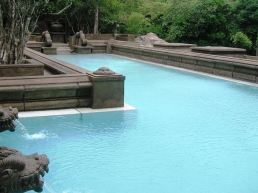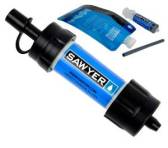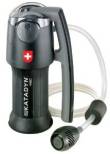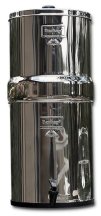 In Part 1 we covered storing water, in Part 2 we discussed transporting it. Planet earth is 90% water, but in a SHTF situation, finding sufficient drinkable quantities of it will be a major challenge. So how do you find sufficient water, and then ensure it is safe to drink?
In Part 1 we covered storing water, in Part 2 we discussed transporting it. Planet earth is 90% water, but in a SHTF situation, finding sufficient drinkable quantities of it will be a major challenge. So how do you find sufficient water, and then ensure it is safe to drink?
Finding Water
Regardless of how much water you store, it is possible that the SHTF situation you are in could go on longer than your water will last. In addition, it might be advisable for you to start looking for water sources immediately and not wait until your supplies are low. In dealing with water, there is one hard and fast rule: NEVER drink any water that you do not know for certain is safe to drink. It either came in a sealed container from a trusted source and you acquired it yourself (store-bought water), it came out of your tap during a time when you could trust the water source (much of your stored water), or you have personally purified it yourself.
In an urban environment, there are a number of sources to find water. In your own home, you have the hot water heater which usually has a drain plug at the bottom. In addition, the water tank on the top of the toilet (NOT the bowl) will be full at first. This water would probably be safe to drink, but you would probably feel better purifying it.  If you have a swimming pool, you can use the water after you safely treat it. Try to treat and store as much of it as possible as soon as you can. In a grid down situation the pumps will not be circulating the water through the filters and at some point it is going to start getting nasty. It is a good idea to have a tarp to cover it to keep blowing dirt and debris out of it. Locate any public swimming pools, indoor motel pools, lakes, or ponds within a short distance from your home. Just remember you wont be the only one seeking water there. Start noting ahead of time the location of nearby water sources. Parks with lakes, ponds, golf courses, waterfall statues, anywhere water is used or would collect in a rain fall.
If you have a swimming pool, you can use the water after you safely treat it. Try to treat and store as much of it as possible as soon as you can. In a grid down situation the pumps will not be circulating the water through the filters and at some point it is going to start getting nasty. It is a good idea to have a tarp to cover it to keep blowing dirt and debris out of it. Locate any public swimming pools, indoor motel pools, lakes, or ponds within a short distance from your home. Just remember you wont be the only one seeking water there. Start noting ahead of time the location of nearby water sources. Parks with lakes, ponds, golf courses, waterfall statues, anywhere water is used or would collect in a rain fall.
In a rural environment, there are additional sources. You should be driving your bug out routes for practice, so start noting on your map any lakes, streams, culverts, ponds, or wind driven water pumps that water live stock. Remember, no matter how nasty and grungy water may look, it can be filtered and purified to make it safe for consumption. Most survival manuals will list a number of ways to find water in arid terrain, including an evaporation still, or digging on the far curve of a dry stream bed. If you live in this type of climate, and these techniques are part of your overall plan, you need to practice these techniques. There are not as easy as they look, and the amount of water you will get is limited.
If you live in this type of climate, and these techniques are part of your overall plan, you need to practice these techniques. There are not as easy as they look, and the amount of water you will get is limited.
Purifying Water
To make water drinkable, you have three basics way to go. Boiling, filtering, or chemical treatment. Prior to any treatment, you should remove as much gunk as you can using coffee filters or a fine cloth such as a T-shirt.
Boiling
Boiling (212 degrees at sea level) for one minute will kill almost all pathogens. But it will not remove heavy metals, and for that you need a good filter. Boiling temperature for water will vary depending on your elevation. For maximum safety, boil your water first, then filter or chemically treat it.
Chemical Treatment
This can include either water purification tablets or using household bleach. If you are using water purification tablets, follow the instructions on the container. Sodium Hypochlorite is the chemical in bleach that disinfects water. Use common household, unscented bleach with a Sodium Hypochlorite rating of at least 5.25%. 2 drops per quart is the recommended amount to use. Insure you splash some of the water on the outside of the neck of the container/bottle to disinfect it also. Wait at least 30 minutes before drinking the water.
Water Filtering
As stated earlier, rough filter any water you are going to purify using coffee filters or fine cloth. Every member of your party should have an individual water filter on them. They are great for drinking on the move. You just put one end of the filter into the water source and suck the water through to drink it. Two of the most popular models are the  Sawyer Water Filter and the Life Straw.
Sawyer Water Filter and the Life Straw.  Both are about equally priced and highly effective. For larger quantities of water, you need a larger filter. There are a number of good models on the market. The Katadyn Vario Water Filter
Both are about equally priced and highly effective. For larger quantities of water, you need a larger filter. There are a number of good models on the market. The Katadyn Vario Water Filter has been around for some time and has a solid following. It will filter up to two quarts per minute in fast flow mode and one quart per minute in longer life mode.
has been around for some time and has a solid following. It will filter up to two quarts per minute in fast flow mode and one quart per minute in longer life mode.
I mentioned that pool water has to be properly filtered. The chemicals that keep it safe to swim in also make it problematic to drink in quantity. I understand that the  Berkey Water Filter is one that will filter the chemicals out and make pool water safe to drink.
Berkey Water Filter is one that will filter the chemicals out and make pool water safe to drink.
Finaly, I would like to dispel a myth that many people seem to believe. They think that if their pet can drink the water, then it must be safe for them. Wrong! Animals and humans have different digestive and immune systems! Ever notice how your dog can lap the water out of your toilet bowl and remain healthy? Go ahead and try that yourself and see what happens!
If you enjoyed this article and found it useful, please click the “Vote for Me” icon at the top right of the page. Thanks!
Pingback: Survival Water Filter by Survival Hax | Azweaponcraftprepper
Be aware that you need to rotate your bleach; it tends to lose its effectiveness over time.
Something advertised as a water “filter” can be quite effective against most biologicals. Note that only a true water “purifier” has effect against viruses.
LikeLike
CBRN decontamination of water is a nightmare.
So many people think that simple activated carbon filters scrub everything from the water. That just ain’t so.
Radio active material is a bad enough problem and foremost in my mind at this moment.
Reverse osmosis is probably best for most of the usual candidates, as well as many other heavy metal contaminants (e.g., arsenic, nitrate, and microbial contaminants). Except some radionuclides, such as iodine-131 which arrive in in a gaseous form, are readily contained in water, and pass right through the RO filters. Now you need that activated charcoal!
Yet again that’s not quite the full ball game.
Adding ion exchange systems (like in water softeners) will clear up the remaining few radionuclides like Cesium-137.
That’s a whole lot of technology isn’t it?
Although it all sounds pretty horrendous, time is your friend with radio active material most having a short “life” span.
There again you’re going to be VERY THIRSTY waiting for uranium to decay with it’s life of millions of years.
LikeLike
Pingback: Water, The Second Consideration Part 3 Finding and Purifying | Azweaponcraftprepper